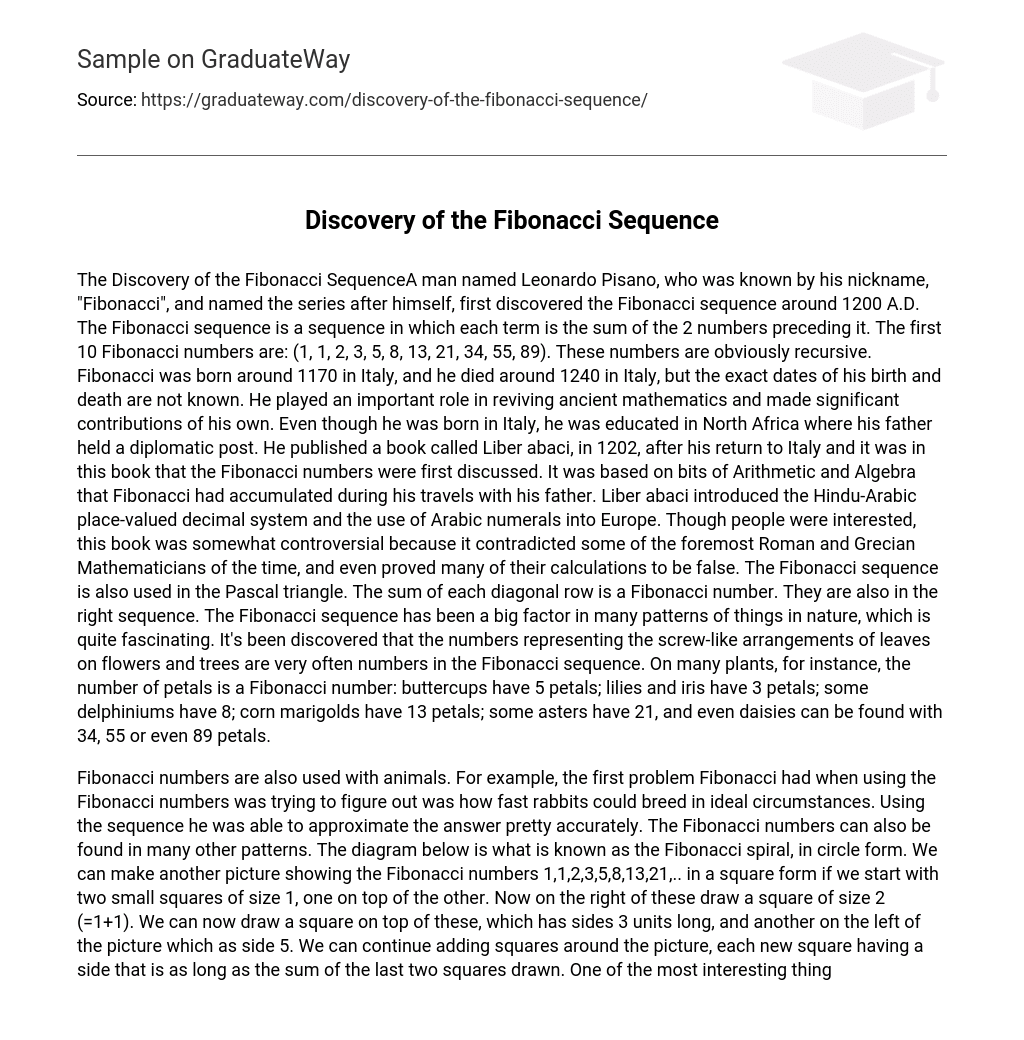The Fibonacci sequence, which was discovered by Leonardo Pisano (also known as “Fibonacci”) in around 1200 A.D., is named after him. This sequence is defined as each term being the sum of the two numbers that come before it. The first 10 numbers in this sequence are (1, 1, 2, 3, 5, 8, 13, 21, 34, and 55), demonstrating a recursive pattern.
Fibonacci, an Italian mathematician born in approximately 1170 and died around 1240, played a significant role in rejuvenating ancient mathematics and making noteworthy contributions of his own. Despite the uncertainty surrounding his precise birth and death dates, Fibonacci received education in North Africa while his father worked as a diplomat. Upon returning to Italy, Fibonacci authored the book Liber abaci in 1202, which introduced the notion of Fibonacci numbers. This publication was influenced by the knowledge of Arithmetic and Algebra that Fibonacci gained during his journeys with his father.
The Hindu-Arabic place-valued decimal system and the use of Arabic numerals were introduced into Europe by Liber abaci. This book caused controversy as it contradicted the calculations of prominent Roman and Grecian Mathematicians, proving many of them to be false. Additionally, the Fibonacci sequence is utilized in the Pascal triangle, where each diagonal row’s sum corresponds to a Fibonacci number. These numbers are also arranged in the correct sequence.
The Fibonacci sequence has been found to play a significant role in various natural patterns, which is quite fascinating. It has been observed that the numbers representing the spiral arrangements of leaves on flowers and trees often belong to the Fibonacci sequence. For example, many plants exhibit a Fibonacci number of petals: buttercups have 5 petals; lilies and iris have 3 petals; certain delphiniums have 8; corn marigolds have 13 petals; select asters have 21; and even daisies can be discovered with 34, 55, or even 89 petals.
Fibonacci numbers have practical applications beyond mathematics, such as studying the breeding patterns of animals. For instance, Fibonacci used these numbers to estimate the reproduction speed of rabbits in ideal conditions.
The Fibonacci numbers can be seen in different patterns, such as the Fibonacci spiral and a square arrangement. In the Fibonacci spiral, they are presented in a circular form. To represent the Fibonacci numbers – 1, 1, 2, 3, 5, 8, 13, 21 and so on – we organize them in a square format. Beginning with two small squares of size 1 positioned one above the other, we connect another square to their right with a size of 2 (the sum of the previous two squares). Continuing this process, we draw squares with consecutive units for sides: first is a square with sides measuring 3 units above the previous one; then on the left side is a square with sides measuring 5 units. This continues by adding more squares where each new square has sides equivalent to the sum of the last two squares drawn.
One interesting aspect of the Fibonacci sequence is the division between each number and its preceding one. For example, dividing 1 by 1 results in 1, dividing 2 by 1 yields 2, dividing 3 by 2 gives us 1.5, dividing 5 by 3 produces approximately
1.666…, dividing 8 by
5 equals about
1.6, and so on. These numbers gradually approach a specific value which is approximately equal to the Golden Ratio: about 1.618034.
The phenomenon of the “Golden Ratio” has captivated mathematicians for centuries. This ratio, expressed as 1 to the irrational number 1.618034…, holds varying degrees of significance among individuals, leading to an exploration into its importance.
The Golden Ratio, also known as the Golden Section or Golden Ratio, has gained significant attention in modern times. It has been extensively used in art and architecture since the Renaissance period, including its application in constructing the Venetian Church of St. Mark during the early 16th century. Additionally, it is commonly utilized for building facades and window sizes, as well as determining the proportion between first and second stories. Sometimes even paintings and picture frames follow its dimensions.
In the 1930s, the Pratt Institute of New York conducted a study on different rectangular proportions arranged as vertical frames. They asked several hundred art students to provide feedback on which proportions they found most pleasing. Surprisingly, the ratio of 1:2 was the least liked, while there was a significant preference for the Golden Ratio. Based on this feedback, it appears that objects created using the Golden Ratio are generally considered visually appealing.
Another intriguing observation is the manifestation of the Golden Ratio in human body measurements. LeCorbusier, a French architect, discovered that the average measurements of the human body from foot to navel and from navel to top of head closely align with the Golden Ratio. He also applied this concept to the ratio between height and arm-span, and incorporated these numbers into his door designs. Although not an exact science due to the reliance on averages rather than precise measurements, these observations nevertheless proved beneficial in his architectural and construction methods.
Research has found that tree-branch patterns often follow the Golden Ratio, although not exactly. Similarly, dendritic cracking in certain metallic alloys, which occurs at very low temperatures, is influenced by the Golden Ratio. In a separate field, Zsolt Lendvai has shown that Bela Bartok extensively employed the Golden Ratio in his music composition. This raises the intriguing question of whether the composer intentionally utilized the Golden Ratio or unconsciously incorporated it due to its pervasive presence in our world, which we perceive as governed by the Golden Ratio.
After conducting research, I have discovered that the Golden Ratio holds significant value in various facets of life. The process of investigating this topic and uncovering additional information about the Golden Ratio and its multitude of applications was captivating.
WORKS CONSULTED
- Smith, Karl J. The Nature Of Mathematics: 9th Edition. 2001
- Ruskey, Frank; Lausch, Scott. “Information on Fibonacci Sequence.” http://theory.cs.uvic.ca/cos/amof/e_fiboI.htm.





